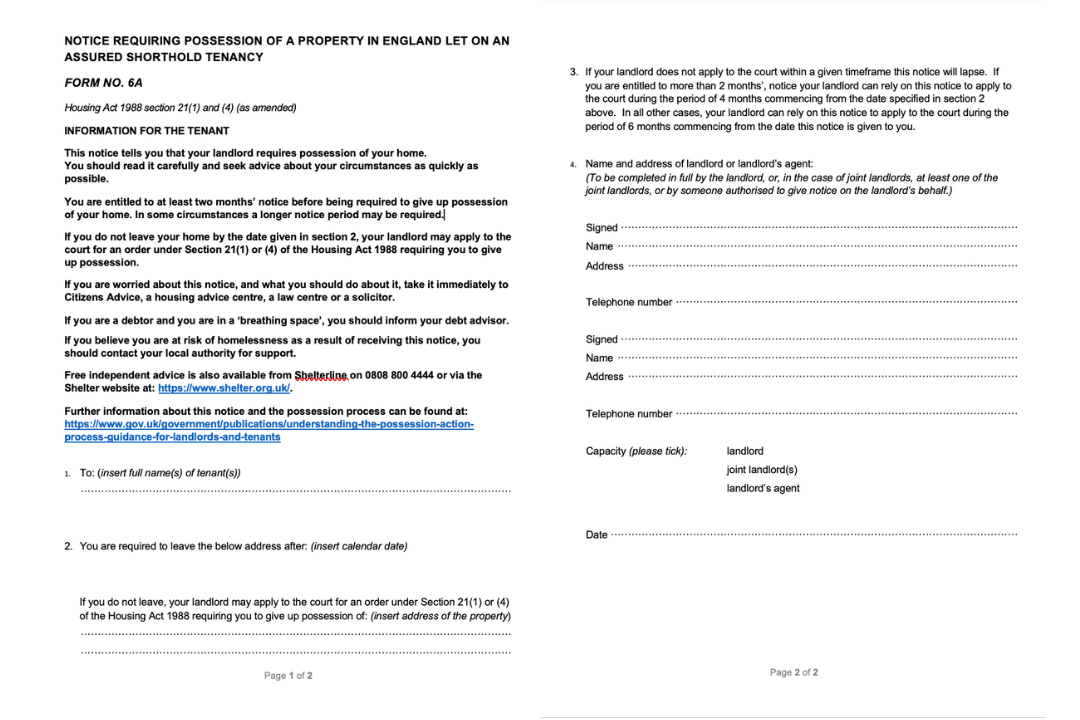
Evicting a tenant is a process that requires clear communication, legal compliance, and formal documentation. If you’re a landlord, having access to a well-structured eviction notice template can make this process less stressful and more efficient. In this guide, we'll explain what an eviction notice template is, when to use one, and how to craft your own.
What is an eviction notice template?
An eviction notice template is a pre-formatted document for landlords. It's used to let tenants know of their intention to terminate a tenancy agreement. It includes key details such as the reason for eviction, the required notice period, and the date by which the tenant must vacate the property.
💡Editor's insight: "You can find and download official eviction notice templates through Gov.UK. Which notice you need to serve depends on your tenancy type. If you're not sure which form to use, always seek legal advice from a qualified possession order solicitor."
Should you use an online eviction template?
Online eviction templates from third parties can be a convenient option, but landlords should approach them with caution. If you do choose to use an online template over the government-provided forms, verify that it complies with current UK eviction laws. Our best advice? Always consult a legal professional to ensure your notice is legally sound.
Pros ✅ | Cons ❌ |
|---|---|
They can save time and effort | May not reflect the latest legal changes |
Often formatted to meet basic legal requirements | May lack flexibility for unique circumstances |
Which form to use for Section 21 notices
A Section 21 notice is the official notice used to evict tenants at the end of their fixed-term tenancy or during a periodic tenancy without citing a specific reason. The official guidance is to use Form 6A, the official form, or to write your own that contains the same information.

*Section 21 form from Gov.UK, as of 2025
Key points about Section 21 notices:
It applies only to assured shorthold tenancies (ASTs)
You must give tenants at least two months’ notice
The notice must comply with legal requirements, such as including prescribed information and serving the notice correctly
Which form to use for Section 8 notices
A Section 8 notice is issued when a tenant has breached the terms of their tenancy agreement. The prescribed form for a Section 8 notice is Form 3. Just like a Section 21 notice, landlords can either use the official form or write their own with the same information.
Key points about Section 8 notices:
You must specify the grounds for eviction, as outlined in Schedule 2 of the Housing Act 1988.
The notice period varies depending on the grounds, ranging from immediate eviction to 14 days or longer.
You can issue this notice at any point during the tenancy.
Other types of eviction notice forms
In addition to Section 21 and Section 8 notices, there are other eviction notice forms landlords may use, depending on the circumstances.
Notice of lease violation explained
A notice of lease violation is issued to tenants who have breached specific terms of their tenancy agreement. It serves as a formal warning and allows the tenant to rectify the issue before further action is taken. If the tenant fails to address the violation, landlords can proceed with issuing a Section 8 notice.
Common violations include:
Unapproved alterations to the property.
Keeping pets without permission.
Noise complaints or disturbances.
How to write an eviction form letter
To stay legally compliant, an eviction notice must include the same information as Form 3 (for Section 8 Notices) and 6A (for Section 21 Notices).
Key components of an eviction letter
Below are some of the most common criteria that an eviction letter can contain:
Header: Include your name and address as the landlord. Add the tenant’s name(s) and address of the rental property.
Subject line: Clearly state the purpose of the notice, for example, “Notice of Termination of Tenancy.”
Reason for eviction: For a Section 21 notice, state that the tenancy is being terminated without fault. For a Section 8 notice, cite the specific grounds and reference the Housing Act 1988.
Notice period: Specify the date by which the tenant must vacate the property.
Details of the tenancy agreement: Include the start date, end date (if applicable), and any other relevant terms.
Legal references: Mention the relevant laws, such as the Housing Act 1988, to demonstrate compliance.
Contact information: Provide your contact details for questions or further communication.
Signature: Sign and date the notice to make it official.
FAQs
How much notice is required to evict a tenant in the UK?
The notice period depends on the type of eviction notice:
Section 21: At least two months.
Section 8: Varies from immediate notice to 14 days or more, depending on the grounds.
Final thoughts
Navigating the eviction process as a landlord can be challenging, but using the right eviction notice template can make the process smoother.
Whether you’re issuing a Section 21 or Section 8 notice, ensuring your documentation is accurate, clear, and legally compliant is key to avoiding disputes. When in doubt, consult with a landlord solicitor or property expert to safeguard your interests and maintain a professional approach.
Disclaimer: The contents of this guide are for informational purposes only and do not constitute legal advice. Always seek professional advice for the latest legal information.